|
In the past 50 years,
Mercedes-Benz S-class was widely recognized as the best series
production luxury car in the world. Without this car, Mercedes would
not have been considered as the best luxury car manufacturer,
especially now its sales volume is eclipsed by BMW. The point is, no
one delivers luxury, comfort and safety as good and as consistently as
the big Mercedes.
How far the history of S-class goes back is always debatable. Mercedes started using the name "S-class" in 1972 (on series W116), but the line obviously had been existing long before that. Because the early cars got only model names, say, 220 or 250SE, it is impossible to tell whether they are S-class models from names. It was not until 1993 that the new corporate nomenclature (model designation started from C, E or S and followed by 3 digits denoting engine capacity) could clearly identify the model class. Mercedes itself said the earliest S-class was W187 series (born 1951). According to wikipedia (well, not always a reliable source) the S-class started from W180 (1954). In my opinion, neither deserved the S-class title. While you may trace its roots to these cars, they were not good and distinctive enough to be seen as a top notch luxury car, because they were mechanically and visually close to the other offerings from Mercedes-Benz then. If S-class means the classiest production model of Mercedes, then the first S-class has to be W111/W112 from 1959. 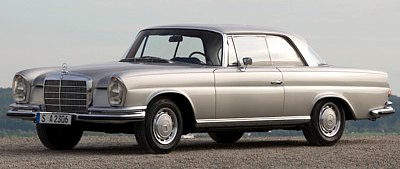 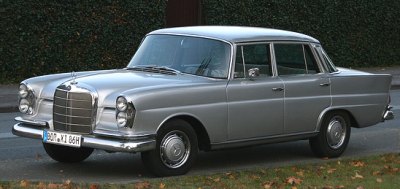 W112 was the luxurious version of W111. Apart from more chromed features and luxury equipment (including air suspensions, all-round disc brakes and power steering), it was available with a 100mm longer wheelbase version. Moreover, it was powered exclusively by a 185hp 3.0-liter fuel-injected straight-six, which was the mass production and alloy-block version of the one serving 300SL. The resultant 300SE was good for 114 mph and 0-60 in just over 10 seconds. The W111 / W112 was probably not yet the best luxury car in the world. However, from its advanced technology and overall refinement it had already shown a promising future. 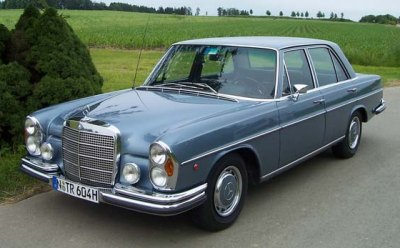 Mechanically, W108/109 was a development from the outgoing generation. The basic design of suspensions and powertrains were carried over, but the six-cylinder engine was enlarged from 2.2 to 2.5 liters and later on 2.8 liters. The latter came with Bosch D-Jetronic electronic fuel injection, which was a progress from the previous mechanical injection. The 2.8-liter engine powered not only 280SE, but also the range-topping 300SEL since the old 3.0-liter engine retired in 1967. Such embarrassing situation continued until 1969 when Mercedes finally developed a new V8 engine. Destined primarily to the USA market, it appeared in two forms: 3.5-liter 200hp or 4.5-liter 230hp. Performance and image were greatly enhanced. 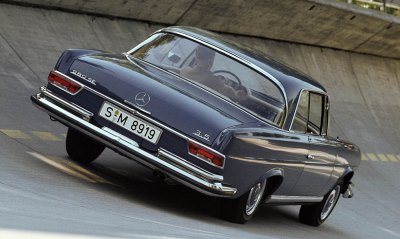 Also worth noting is the high-performance 300SEL 6.3, which was fitted with a mega V8 from the 600 limousine. It will be covered by a separate article. Thanks to its solid build quality, superb mechanical refinement and elegant yet restrained style, the W108/109 S-class overtook the American Cadillac and Lincoln to be the world's best luxury car. Since then it never looked back. 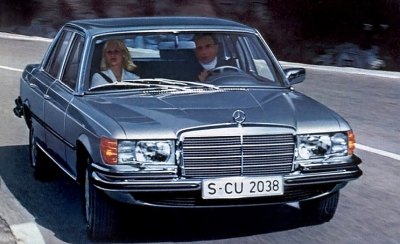 Style-wise, the W116 was a brave (an unsuccessful) attempt for modernization. Its body shell was widened and lowered. The radiator grille evolved shorter and wider, while traditional circular headlights were replaced with two large rectangular ones with signal lamps integrated. Weight went up by around 100 kg, mostly due to improved safety. To enhance crash protection, the cabin section was made stiffer, and further research improved the progressive crumpling of the front and rear crumple zones. In the cabin, collapsible steering wheel, recessed switches and padded surfaces reduce the level of injury in collision. Fuel tank was relocated from the tail to above the rear axle. These features made the S-class the safest car in the world. Moreover, in its final year, it introduced the world's first ABS anti-lock brake system. The chassis was a big departure from the previous generation. While the front double-wishbone setup sounds similar, it got anti-dive geometry and zero Kingpin offset (i.e. the steering axis falls onto the center of tire contact patch). The latter improved its steering response and reduced kickback a lot. At the rear, the low-pivot swing axles finally became history, as they were replaced with semi-trailing arms. This tamed the oversteer of its predecessor, making its handling safer and more predictable. 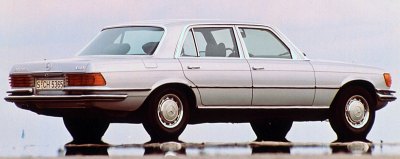 Autocar tested both 280SE and 450SEL. They topped 125 mph and 134 mph respectively, and accelerated from rest to 60 mph in 9.7 and 9.1 seconds respectively. The 280SE was praised for sweet revving engine, good handling and ride. Performance of 450SEL was disappointing, partly due to the power-sipping 3-speed automatic (lesser models used 4-speed auto), partly due to its extra weight. However, the British magazine praised it for refined ride, responsive handling that belied its size and superb power steering. The latter was light yet quick and free of kickback. No wonder 450SE/SEL was crowned European Car of the Year in 1974. Like the previous generation, W116 was offered with a high-performance model, 450SEL 6.9. This will be dealt with a separate article. 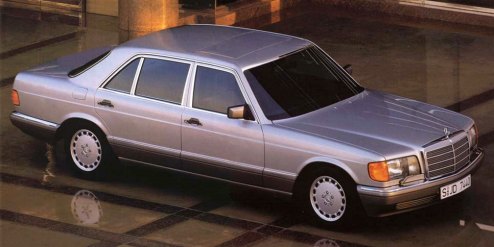 A couple of things mark W126 out of other S-class series. The first is a timeless design. Most cars age within a few years. Good designs may manage 20 years. But the W126 seems never age. Even today, 30 years after its debut, it still looks as handsome and elegant as before. A key contribution is the way it treated bumpers and side skirts, making them working in harmony with the rest of the body. However, most important is it did everything so right. The transition from one plane to another is smooth and flawless. The integration of features into the car approaches perfection. The only thing prevents it from matching W108 is the lack of classical features, which made it less special from modern eyes. That said, give it another 20 years and car collectors then may have different view. 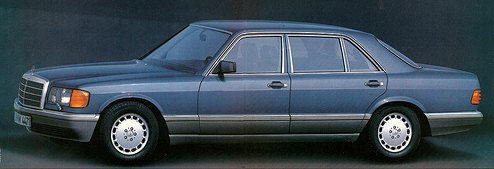 Another thing marks the W126 out is the sense of solidity it delivers. This can be seen externally, of course, but the feel gets stronger once you have sat inside. From its structure and build quality, this S-class feels incredibly solid. It is void of the complication and unreliability of subsequent S-classes, just gives you a very dependable feel. The chassis of W126 was an evolution from the previous generation. This mean it continued to employ semi-trailing arms as rear suspensions. The biggest advancement was aerodynamics (coefficient of drag lowered from 0.41 to 0.36) and weight reduction. They contributed to a 10-percent reduction of fuel consumption. Besides, more safety features were introduced to keep it at the forefront of safety, for example, air bags, seatbelt pretensioners and the standard fitment of ABS. At launch, it offered 3 choices of engines: the carried over 185hp 2.8 dohc straight-six (280SE/SEL), new 218hp 3.8-liter sohc V8 (380SE/SEL) and 240hp 5.0-liter sohc V8 (500SE/SEL). The V8s were developed from the old 3.5 and 4.5-liter unit respectively, but with capacity increased and changed to alloy block to save weight. 4-speed automatic transmission became standard on most models, and now they were computer-controlled. They provided two shift patterns, Sport and Economy, and shift points were adaptive to driving conditions. 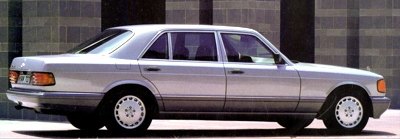 During its long life, the S-class was facelifted once and got engine updates many times. The 3.8 V8 was superseded with 4.2-liter unit (420SE/SEL). The 2.8 engine was substituted by 2.6 and 3.0-liter sohc sixes. Following the introduction of 5.6-liter V8 in 1985, 560SEL became the flagship model. In Europe it was good for 300hp and 155 mph, although Autocar thought it was not as accomplished as BMW 750i, which was V12-powered. On the road, W126 was praised for well-weighted power steering, excellent high-speed stability and a nimble handling for its size. Its semi-trailing arm suspensions made it an inherent understeerer, but by applying power it could be turned into progressive power slide. On the downside, its ride was slightly too firm for a luxury car (I can confirm this, as I had a couple of rides in the car), and both wind and road noises were not very well insulated from the cabin. Such a combination of handling and ride characteristic was quite surprising. 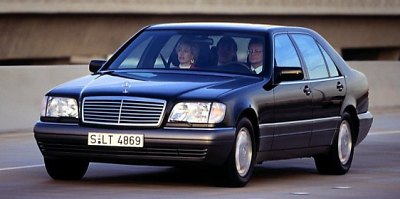 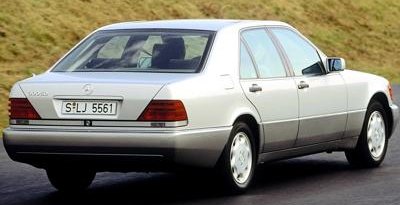 On the other hand, the press thought it was simply too much - too big, too expensive and too environmental unfriendly. It did not beat its rivals squarely and fairly, just overwhelmed them with more mass, more sophistication and more money. This negative image would not be overcome until the next generation arrived. It should be noted that the model designations of S-class were changed in 1993. Following the new corporate nomenclature, 300SE, 400SE, 500SE and 600SEL were renamed to S320, S420, S500 and S600 respectively. 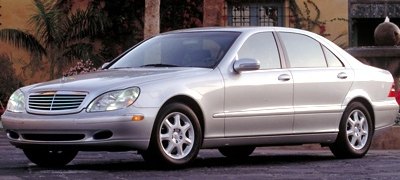 The W220 was being developed at a time Mercedes started getting radical - both in design and development process - under the leadership of its CEO Jurgen Schrempp. Its sleek new look appeared to be much younger than ever, but many radical elements, such as the peanut-shaped headlights, round bumper intakes and slim radiator grille, aged quickly over time. This mean it looks rather outdated today. The build quality and reliability also took a nose dive as Schrempp drove for cost-effective engineering. The W220 used cheaper materials in its cabin and its development and testing process was shortened. The latter resulted in many electronics glitches. This was not helped by its vast extension of electronic technologies, e.g. AIRmatic adaptive air suspensions, CCS cylinder cut-off (on 5.0-liter V8), Distronic and Speedtronic computer cruise control, ESP stability control, BAS brake assist, integrated infotainment system... 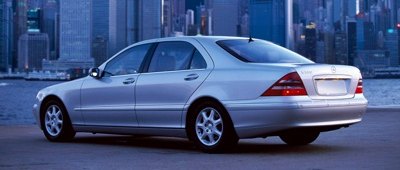 To standardize engine production and save costs, W220
employed a 90-degree V6 and V8 family. The former needed a balancer
shaft to cancel first order vibration. Mercedes believed 4 valves per
cylinder could not comply with the cold-start emission requirements of
EU 2004 emission standard (which was proved to be wrong), so these
engine reverted to SOHC 3 valves per cylinder. The resultant power loss
was largely compensated by using dual ignition, variable
intake manifolds and intake variable valve timing. Broader torque
delivery actually made the cars perform better in real world. At the
top of the range, a new 367hp 5.8-liter V12 was developed for S600,
again based on the SOHC 3-valve design of the V6 / V8.
In 2002, the V12 was added with twin-turbo, boosting output to an incredible 500hp. The new S600, equipped with Active Body Control suspensions, became an Autobahn rocket. Meanwhile, AMG joined the party with two fast S-class, S55 (powered by 500hp 5.5 supercharged V8) and S65 (612hp 6.0 twin-turbo V12). They had sportier handling and coarser ride than the standard car. However, the regular W220 was never short of talent in handling. The switch from recirculating ball to rack-and-pinion steering improved its steering feel and precision a lot, while adaptive suspensions (AIRmatic or ABC) improved its body control without sacrificing ride quality. It was considered to be a good compromise between handling and comfort. Commercially, the W220 was more successful than W140. However, its downgraded reliability and build quality cost Mercedes heavily in reputation. 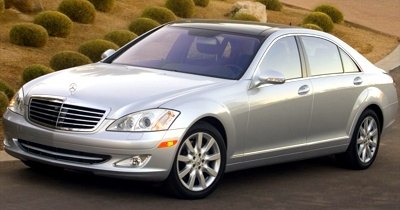 Mercedes learned from
mistakes in the past. After the over-engineered W140 and the
underdeveloped W220, it finally hit the right balance with W221. The
new S-class is sized between the two, offers enormous interior space
yet weighs only 65 kg more than W220, thanks partly to aluminum hood,
trunk lid, doors and front fenders. It keeps a sleek profile and low
drag, but the detailed design is far more graceful than the old car.
Inside, the new S-class has its materials and build quality vastly improved, getting back to the top of the game. High-tech features like LCD instrument panel, Night View infrared camera and Pre-Safe safety system distinguished it from rivals. Same go for the super-comfortable front chairs, which come with heating, cooling, massagers and side bolsters that inflate automatically during hard cornering to hold the occupants firmly in place. Besides, the cabin is remarkably quiet and free from road intrusions. The chassis is an evolution of the outgoing series. The suspension geometry, adaptive air suspensions and steering were refined without big changes. S600 continues to employ active body control. Again, the S-class does not steer as well as BMW 7-series, but it provides a smoother and quieter ride, thus is unquestionably the better luxury car. 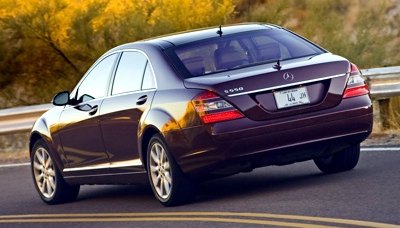 The twin-turbo V12 of S600 is largely the same as before,
only got a slight, 17hp boost in output. Other engines were renewed.
The 90-degree V6 and V8 got 4-valve heads, dual continuous variable
valve timing as well as extra capacity, boosting output considerably.
Furthermore, the automatic gearbox was upgraded from 5 to 7-speed (S600
kept the 5-speeder as the 7G-Tronic could not withstand its tremendous
torque). As a result, all S-class models bar the S600 are significantly
quicker than their predecessors. AMG models include S63 and S65, the
former got an all-new 525hp 6.2-liter 32-valve V8, while the latter
carried over the old engine.
By the turn of the decade, Mercedes focused its development to the green side. In Europe, more and more sales fell to its ever maturing V6 turbo diesel. Meanwhile, Mercedes also introduced S400 Hybrid (powered by V6 plus a small electric motor integral with transmission) as an attempt to narrow the gap from Lexus. In 2010, the V6 and V8 family was overhauled to achieve a 25 percent reduction in emission and fuel consumption. The 90-degree V6 was replaced with a 60-degree V6 with direct injection, auto start-stop and other fuel-saving designs. The new V8 got the same technology, plus a reduction in capacity and addition of twin-turbocharger. The result is even better performance, drivability yet more environmental friendly. AMG's 6.2 V8 was also replaced with a twin-turbo 5.5 V8, with similar improvements. Although the W221 is still in production at the time of writing, we can conclude that it is a better car than its two predecessors. However, as the S-class is facing tougher competition than ever, it seems difficult to repeat the success of W126 in the foreseeing future. |